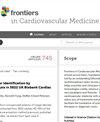Association between fatty liver index and cardiometabolic multimorbidity: evidence from the cross-sectional national health and nutrition examination survey
IF 2.8
3区 医学
Q2 CARDIAC & CARDIOVASCULAR SYSTEMS
引用次数: 0
Abstract
BackgroundMetabolic dysfunction associated steatotic liver disease (MASLD) contributes to the cardiometabolic diseases through multiple mechanisms. Fatty liver index (FLI) has been formulated as a non-invasive, convenient, and cost-effective approach to estimate the degree of MASLD. The current study aims to evaluate the correlation between FLI and the prevalent cardiometabolic multimorbidity (CMM), and to assess the usefulness of FLI to improve the detection of the prevalent CMM in the general population.Methods26,269 subjects were enrolled from the National Health and Nutrition Examination Survey 1999–2018. FLI was formulated based on triglycerides, body mass index, γ -glutamyltransferase, and waist circumference. CMM was defined as a history of 2 or more of diabetes mellitus, stroke, myocardial infarction.ResultsThe prevalence of CMM was 10.84%. With adjustment of demographic, anthropometric, laboratory, and medical history covariates, each standard deviation of FLI leaded to a 58.8% risk increase for the prevalent CMM. The fourth quartile of FLI had a 2.424 times risk for the prevalent CMM than the first quartile, and a trend towards higher risk was observed. Smooth curve fitting showed that the risk for prevalent CMM increased proportionally along with the elevation of FLI. Subgroup analysis demonstrated that the correlation was robust in several conventional subpopulations. Receiver-operating characteristic curve analysis revealed an incremental value of FLI for detecting prevalent CMM when adding it to conventional cardiometabolic risk factors (Area under the curve: 0.920 vs. 0.983,脂肪肝指数与心脏代谢性多病之间的关系:来自全国健康与营养状况横断面调查的证据
背景代谢功能障碍相关性脂肪性肝病(MASLD)通过多种机制导致心脏代谢疾病。脂肪肝指数(FLI)是一种非侵入性、方便且经济有效的方法,可用于评估脂肪肝的程度。本研究旨在评估脂肪肝指数与流行性心脏代谢性多病(CMM)之间的相关性,并评估脂肪肝指数对改善普通人群中流行性CMM检测的有用性。FLI 根据甘油三酯、体重指数、γ -谷氨酰转移酶和腰围制定。CMM定义为有2次或2次以上糖尿病、中风和心肌梗死病史。在对人口统计学、人体测量学、实验室和病史等协变量进行调整后,FLI的每一个标准差都会导致CMM患病风险增加58.8%。FLI的第四四分位数比第一四分位数患流行性CMM的风险高2.424倍,而且有风险升高的趋势。平滑曲线拟合显示,随着FLI的升高,CMM的患病风险也成比例增加。亚组分析表明,在几个常规亚人群中,相关性很强。接收者工作特征曲线分析表明,当将 FLI 加入常规心脏代谢风险因素时,FLI 在检测流行性 CMM 方面的价值会增加(曲线下面积:0.920 vs. 0.983,P < 0.001)。结论我们的研究表明,FLI与流行性CMM之间存在正向、线性和稳健的相关性,我们的研究结果暗示了FLI在改善普通人群中流行性CMM检测方面的潜在作用。
本文章由计算机程序翻译,如有差异,请以英文原文为准。
求助全文
约1分钟内获得全文
求助全文
来源期刊

Frontiers in Cardiovascular Medicine
Medicine-Cardiology and Cardiovascular Medicine
CiteScore
3.80
自引率
11.10%
发文量
3529
审稿时长
14 weeks
期刊介绍:
Frontiers? Which frontiers? Where exactly are the frontiers of cardiovascular medicine? And who should be defining these frontiers?
At Frontiers in Cardiovascular Medicine we believe it is worth being curious to foresee and explore beyond the current frontiers. In other words, we would like, through the articles published by our community journal Frontiers in Cardiovascular Medicine, to anticipate the future of cardiovascular medicine, and thus better prevent cardiovascular disorders and improve therapeutic options and outcomes of our patients.
文献相关原料
| 公司名称 | 产品信息 | 采购帮参考价格 |
|---|
 求助内容:
求助内容: 应助结果提醒方式:
应助结果提醒方式:


